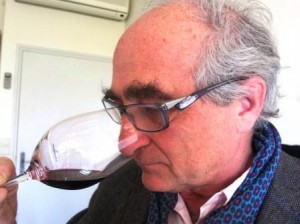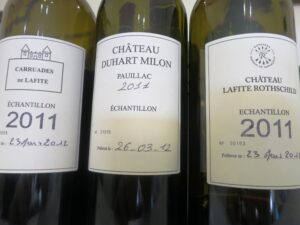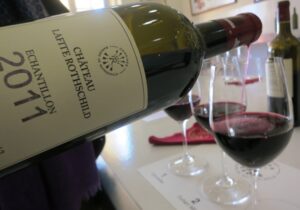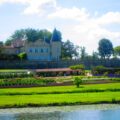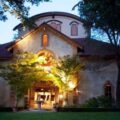2011 Lafite Rothschild – Produced from a blend of 80% Cabernet Sauvignon and 20% Merlot. Spice, blackberry liqueur, licorice, earth, graphite and gravel scents lead to a full-bodied, structured wine with ripe, powerful tannins, freshness and good concentration, the wine ends with a bright, elegant, cassis-filled finish. 95-96 Pts
2011 Carruades de Lafite – 55% Cabernet Sauvignon, 39% Merlot, 3.5% Cabernet Franc and 2.5% Petit Verdot produced a wine with scents of forest floor, cassis and black cherry. Medium bodied with cassis, spice, black olive tapenade and bright sensations. 88-90 Pts
2011 Duhart-Milon 75% Cabernet Sauvignon and 25% Merlot make up the blend. With a perfume of black cherry, smoke and lead pencil, the wine offers ample, fresh, chewy Cabernet flavors and cassis. 92-93 Pts
We spoke with the director of Lafite Rothschild, Charles Chevallier about the estate, their wine making, the harvest and his taste in wine and of course, 2011 Lafite Rothschild.
Jeff Leve: Do you have a favorite style of vintage for Lafite Rothschild?
Charles Chevallier: “I prefer drinkable vintages of Lafite Rothschild that will age. For lunch, I enjoy younger vintages at 10-15 years of age. For dinner, I prefer older wines with more complex aromas and flavors.”
Jeff Leve – I could be wrong, but I am assuming you do not drink Lafite Rothschild on a daily basis. For regular dinners at home, what wines do you enjoy?
Charles Chevallier: “My tastes remain very French. I like a wide variety of wines. Recently, I had a nice Entre deux Mere. I am very fond of Sauternes with dinner”.
Jeff Leve – With 110 hectares currently in production, what is the average age of the vines used in Lafite Rothschild?
Charles Chevallier: “While the average age of the vineyard is 40 years, our oldest vines come from a small parcel that is 123 years old!”
Jeff Leve – In total, what percentage of your vineyards does that represent?
Charles Chevallier: “Less than 1% of the vineyard is that old”.
Jeff Leve – What is your replanting program at Lafite Rothschild?
Charles Chevallier: “On average, between 1% and 1.5% of the vineyard is replanted every year”.
Jeff Leve – Some journalists and consumers claim Bordeaux has lost its soul. The wines have moved too far in the modern direction. Do you think older tasters from a few generations ago would recognize the wines of Lafite Rothschild?
“Charles Chevallier: “I do not agree with that. There has been a lot of progress and evolution in the vineyard work, but the wines are similar in style. A few years ago, I attended a vertical featuring 120 vintages of Lafite Rothschild. The tasting was in Brazil. That tasting made it easy to see a line from the past to today. Tasters from previous generations would definitely recognize the wines”.
Jeff Leve – What are the biggest advances and changes made at Lafite Rothschild since you started with the property in 1983?
Charles Chevallier: “The major changes at the chateau are seen in more difficult vintages. We also have a greater understanding of the malolactic process.”.
Jeff Leve – Is this primarily from the aromatics, texture or flavor?
Charles Chevallier: “Lafite Rothschild is found more in the nose and not in the mouth”.
Jeff Leve – Continuing to look back in time, when the classification took place in 1855, what was the blend in those days?
Charles Chevallier: “Blends were not that much different than they are today. Cabernet Sauvignon was always the most important varietal in the vineyards. Malbec and Carmenere were planted in small amounts. They were eliminated after phylloxera.”
Jeff Leve – What portion are you farming using organic methods?
Charles Chevallier: “100% of the fertilizers today are organic. During the fight against mildew, we use the minimum amount of chemicals to take care of the health of our vineyards”.
Jeff Leve – “Chateau Latour is starting to use biodynamic farming and Chateau Pontet Canet is certified as Biodynamic. Would you ever consider biodynamc farming at Lafite Rothschild?
Charles Chevallier: “Not at Lafite Rothschild”.
Jeff Leve What is your opinion of optical sorting for Lafite Rothschild? Did you use it this year for 2011 Lafite Rothschild?
Charles Chevallier: “We prefer to rely on 300 to 400 experienced people who use their two eyes. The machines are efficient. The result is technically fine. We did not use it for 2011 Lafite Rothschild. We prefer people who know how to pick what we are specifically seeking from each vintage. This allows us to harvest one grape at a time, if that is our choice. “
Jeff Leve – What qualities are you seeking in the berries when you decide to harvest at Lafite Rothschild?
Charles Chevallier: “Part of the complexity in Chateau Lafite Rothschild is the mixture of the grapes picked at different levels of ripeness. Machines go too far in the selection. Optical sorters would produce a less complicated and more standardized style of Lafite Rothschild than we are looking for”.
Jeff Leve – What is the biggest change you’ve made in vineyard management techniques over the past decade?
Charles Chevallier: “More time is spent in September to control the maturity of the vines and fruit. Most of my time is spent eating and tasting grapes in the vines”.
Jeff Leve – During fermentation, you use wood, stainless steel and concrete vats. How do you decide what goes into each vat?
Charles Chevallier “The determining factor is the parcel size. Our largest vat is wood, which holds 300 hectoliters. Our steel vats are 220 hectoliters.”
Jeff Leve – What about your concrete vats?
Charles Chevallier: “Our concrete vats are new. They were used for the first time in 2011. They are small and range in size for 40 to 100 hectoliters. Concrete is used mostly for our Merlot parcels”.
Jeff Leve – How much of your vineyards damaged by the September hail storm? Did they effect the 2011 Lafite Rothschild?
Charles Chevallier: “Only 4 hectares were damaged. So, there was no real effect on 2011 Lafite Rothschild.”
Jeff Leve – Did the storm cause you to harvest earlier than expected with regards to 2011 Lafite Rothschild?
Charles Chevallier: “We started to pick 2 days earlier than we originally anticipated”.
Jeff Leve – What details can you tell me about your new winery project in Penglai in the China Shandong province?
Charles Chevallier “I am not involved in the Chinese project. My previous assistant, Eric Kohler, is managing the winery. Currently, the cellars are not yet built. They are planting 25 hectares of vines”.

